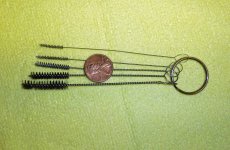>> DRILL PRESS TIPs <<
There are THREE holes around a keyed chuck for a reason.
There are also three "bit grippers" to match those three holes.
When chucking a bit, progressively tighten in ALL THREE HOLES, going from hole to hole, tightening a little more each time.
Doing thus, your bits will be held tighter and the chuck will last much longer.

---------------------------------
When a chuck is so tight that you can't loosen it with the key, remove the bit from one of those 4-in-1 screw-drivers and use the hollow shaft for a "cheater bar".
Better yet, take some two-part plumber's epoxy stick and permanently afix the chuck-key into the shaft of the screw-driver that you already lost/broke the bit, thus making a nice chuck key with extra leverage.

-----------------------------------
To contain the mess when using cutting oil on the bit, put a block of wood for support, or the vise, inside a shallow card-board box on the drill-press table with the flaps standing up.
Crumple up plenty of old papers/rags inside the box to soak up the oil.
The box flaps will catch most of the sling-off and most of the oily shavings will fall into the box.

-------------------------------------
When drilling larger holes through steel, there is a point when the bit is almost through, when there is only a thin ring of material around the perimeter of the hole, that the bit starts violently grabbing.
Before breaking another bit, or getting knocked in the head when your project gets hurled at you by the spinning bit, STOP RIGHT THERE and quit drilling.
Put the work-piece in the vise and finish reaming that last bit of metal with the die-grinder.
Your bits will live much longer and your work will be safer.

---------------------------------------
Keep the drive-belts just loose enough that, when the bit grabs and wants to sling the work-piece across the shop, the belts slip instead.
My press has been set up as such and I haven't worn out a belt, nor spun a bearing, in over thirty years.
Also, my many years as a horse-shoer has trained my instincts to know just when a machine is fixing to "kick" and I un-consciously compensate by immediately tightening my hold on the work-piece.

-----------------------------------------
For precision drilling, they make such a thing as a center-drill, which is a fat-shanked bit with a very skinny tip.
The fat shank prevents the bit from flexing, while the small tip centers within the punch mark and cuts a pilot hole.

------------------------------------------
I have one of those spring-loaded center punches that simply pushing down on it "snaps" the internal hammer and strikes the punch; it is about the handiest item I ever used for center punching.



